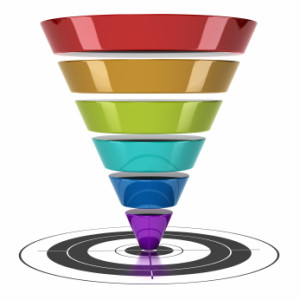by gabriel_sales | May 28, 2015
 Do you often wonder what you can do to get your content marketing to convert?
Do you often wonder what you can do to get your content marketing to convert?
While pondering this question myself I got to thinking about my daily life. Have I seen anything lately that has made me want to click, have I purchased anything recently after seeing an advertisement and what email marketing campaigns have I opened? Then I realized I was looking at this the wrong way. I needed to look more at my daily life and routines; what gets me to take action?
I often write myself reminders on fluorescent colored sticky notes and place them where I look daily. For example my notes usually end up on the bathroom mirror or on the refrigerator. This seems like a fool proof way to remind myself to do things. The problem is that the sticky notes catch my attention the first couple times, but eventually I procrastinate long enough or walk by them so often that I stop noticing the fluorescent notes dotted around my house.
Sometimes my cleverly placed notes do the trick but most of the time they get ignored. So, how do I remind myself to do things? It’s quite the process to be honest.
First I write it down on that hopeless little sticky note. You know, just in case it works.
Second, I put the to-do in my calendar with an alert triggered for a day or two before my deadline. Now we all know life can be crazy so when this alert goes off 50% of the time I’m already engaged in another activity.
This brings me to my third and final tactic; setting an alarm on my phone. Now, this alarm is set strategically for a time that I’m usually not busy, like after nine pm on a weekday or prior to my usual wake up alarm. When my alarm goes off at one of those times I know it is important and I’m sent into action.
What has become obvious to me is that it takes different types and repetitive reminders for me to take action. Now these aren’t life and death situations just to dos that should be done to make my life better and/or easier. I don’t think I’m the only one who works this way when presented with a good idea/opportunity that is non-emergent.
This behavior is also present in the buying process and needs to be addressed.
You aren’t going to hit your sales goals by engaging with a prospect once and it is rare to convert using only one sales/marketing tactic. One key to selling is content variety.
Like the sticky notes you need an introduction to create awareness of your product. Let’s say you start with cold calling. You get a few interested prospects but no one buys. What do you think is the next step? Continue to call or send them information on the product?
It’s time to engage your prospects with digital content. Get your prospects to look at you again and take notice – your content marketing is to your prospects as the calendar reminder is to me. Now that you have their attention address their pain points, educate them on your solution and move them towards the decision making stage.
Digital content is most easily shared with specific prospects via email. When using email as your communication platform your content is being delivered the same way every time but your content shouldn’t be the same. Make each email new and fresh with different subject lines and offers. The first step to getting prospects engaged is getting them to open the emails. Get variety in your subject lines by using questions and calls to action and also varying the length of the subject line.
Once your prospects are opening the emails you need them to click on your content. Again, if you’re always sending them the same thing they will start ignoring your efforts. In order to incorporate content variety; maybe you start by sending intro copy about your product, and then send a problem/solution video, then a microsite followed by case studies and or a white paper.
Now that your prospects are engaged it is key to make sure that the content on your website, blog and social media also have content variety. You’re targeting a large group of people with different pain points and personal preferences on how they consume information.
You have placed your sticky notes and you have enhanced awareness with your calendar reminder, now all you have to do is set the alarm to get your prospects to take action. This seems like a daunting task but it is easily done through scoring content and tracking prospects through marketing automation. You can see where your prospects are in the buying process by what links they are clicking, the pages they are visiting and whether or not they are filling out forms or downloading case studies or white papers. When you can see that they are engaging and getting close to the decision stage it is time to call them. Get them to schedule a time to view a demo and get in contact with your closer.
Your strategy may differ from this example, however, as long as you are communicating through multiple platforms and you have content variety you will obtain and keep the attention of your prospects. If you are relying on one repetitiveness without variety your prospects will stop noticing you and won’t take action.
For more tips on content creation to enhance your sales process, read “5 Steps to B2B Content Engagement Success.”
To learn more about Gabriel Sales and our sales marketing strategy please contact us.
by gabriel_sales | Jun 27, 2014
 By now, everyone in B2B knows that quality marketing content can contribute directly to sales. The idea is that by giving your prospects valuable content that assists them in their buying process, you help build the trust required to motivate a purchase.
By now, everyone in B2B knows that quality marketing content can contribute directly to sales. The idea is that by giving your prospects valuable content that assists them in their buying process, you help build the trust required to motivate a purchase.
In attempting to use marketing content for sales objectives, one mistake a lot of companies make is failing to help prospects move smoothly through each stage of their buying process. Many companies simply make a bunch of content, throw it up on their website and expect magic to happen. There’s a little more to it than that.
The content you create, whatever it says, needs to help guide prospects—stage by stage—through your sales cycle. This means you need to different create content for each stage (discovery, education, verification, etc.) that speaks directly to the main interests and concerns prospects have while in each stage.
For example, let’s say you are selling marketing automation software. Some of your early-stage prospects are going to have no idea what marketing automation is. For these prospects, you need to have some light, educational content that answers the basic question, “What is Marketing Automation?” However, other prospects are already going to know a lot about marketing automation and want content that helps them to compare options and verify they’re making the right choice. For these prospects, different content—e.g. a software comparison matrix—is needed to assuage concerns and keep the deal moving forward.
Once you have content created for each stage of your buyer’s journey, you are almost set up for success, but not quite. The final step is connecting the dots for your prospects, so they can take themselves through your sales process on their own. This is relatively easy to do, but requires some thought.
Connecting the dots for your prospects requires getting into their head and figuring out how a prospect is likely to think through your buying process. Using the example above, an early stage marketing automation shopper will first wonder, “What is marketing automation?” then, they might ask, “What advantages will marketing automation give me?”. If the prospect is still interested at this point, they might ask, “Is my company ready for this type of investment?” Once a prospect has decided they want to make a purchase, their questions might change to things like, “What is the implementation process like?” or “What payment options do I have?”
As you can see, each of these questions requires a different piece of marketing content. However, you can make the process of going through all the content smoother by leaving different links or ‘breadcrumbs’ that guide prospects logically through each stage. Using our marketing automation example, at the end of the “What is marketing automation?” content, add a link to a blog on “5 Advantages of Marketing Automation in 2014”. At the end of the ‘advantages’ blog, leave a link to a video on “How to know if your company is ready for marketing automation”. And on and on to the end of your sales cycle.
Many times, prospects only need a little bit of help to get them to take an action to take the deal forward. By making it as easy as possible for prospects to self-educate and take themselves through their own buying process, we make it more likely that prospects will like us and eventually, trust us enough to make a purchase.
Read more about creating content for sales in 5 Steps to B2B Content Engagement Success.
by gabriel_sales | Jun 19, 2014
 On the internet, you run into a lot of different types of people: bloggers, shopping addicts, trolls, information junkies, conspiracy theorists, hackers; this list goes on and on. However, in terms of commercial activities, there are generally only two types of people you need to pay attention to: searchers and sharers.
On the internet, you run into a lot of different types of people: bloggers, shopping addicts, trolls, information junkies, conspiracy theorists, hackers; this list goes on and on. However, in terms of commercial activities, there are generally only two types of people you need to pay attention to: searchers and sharers.
Searchers and sharers are different breeds. One lives on SERPs and the other on social platforms. They also have different desires, different motivations and different end goals.
Searchers
People who access content via search engines are looking for something specific. They have a specific question in mind and want the answer to that question now. They don’t want to have to scroll through endless text on to find the one detail they want; they would prefer it if their answer is in the first sentence of the webpage.
In terms of marketing content, this means that searchers want information to easily locatable and extremely clear in terms of meaning. Titles can play a big role here as having the right keywords in your title is still a big factor in terms of where you rank on SERPs. Additionally, when designing content for searchers, ask yourself, “Does this content thoroughly and accurately answer a question my target demographic might have?” If so, you’re on the right track.
Sharers
Those who access your content via social media are generally in a very different headspace than people who are searching. People who search are usually thinking, “I need to find this answer. Now.” Conversely, people who are on social media might be thinking, “Please distract me from how bored I am at work,” or “I need a break. Let me check my Facebook.” People on social media, or ‘sharers’, usually do not have a pressing need when accessing marketing content and are looking to be distracted or entertained in some way.
The content that will best engage sharers is therefore going to be slightly different than the content that engages searchers. You can take a little bit more creative liberty with your titles for sharers, as the best optimized titles for SEO aren’t necessarily the most human-friendly and attention-grabbing. Finally, sharers also want content that educates or provides enough entertainment value to warrant actual ‘sharing’—so here is the chance to let either your intellect or personality shine.
For more tips on creating B2B content for SERPs and social, read 3 Tips to Improve B2B SEO in 2014. Feel free to contact us with any questions.
by gabriel_sales | Jun 19, 2014
B2b content engagement (continued) 
This is the second part of a 2 part blog on B2B content engagement. You can find part 1 here.
3. Make your prospect the hero
If the story you are telling in your marketing content features you as the main protagonist, you’re doing yourself a disservice. Building on the point above, stories enable people to imagine themselves in other scenarios and internalize new ideas or beliefs as their own.
By creating a story that allows your prospect to imagine himself as a hero (e.g. saving the day and earning the boss’s praise for finding the perfect solution for X), you create a major incentive to transact, so he can become that hero he imagined.
- Set up an emotional experience
We’ve written previously on why emotional connection matters more in B2B than in does in B2C. One aspect is that with higher risk sales, people need emotional assurance that things will go well in order to ease their anxieties.
Additionally, “behavioral psychologists have long argued that only 30% of human decisions are actually driven by rational considerations. This means more than 70% of customer loyalty and spending decisions are based on emotional factors.” Because we are so emotionally motivated, anything you can do to create an emotional experience for your readers will keep them more engaged. There are many ways you can facilitate an emotional response in your marketing content—humor, building action to create excitement, ending with a ‘hook’ to keep people coming back for more, etc.
5. Get it out there. Fast.
One of the biggest mistakes B2b companies make in their initial content marketing efforts is thinking that all you have to do to get prospects to engage with you is post content on their website. In terms on engagement, publishing content—like a blog—should merely be the first step in getting the content to your target audience.
Additionally, founder of Moz Rand Fishkin recently wrote that in terms of SEO, “One of the harsh truths of blog-focused SEO is that a few hours after a post is published, 90% of the ranking ability is spent. . . It’s that first burst of activity – of social sharing and people emailing it around and links coming in – that set the stage for ranking success in the search engines.” This means that the quicker you can get your content out and shared on a variety of platforms, the wider the reach your content will have and consequently, the more engagement.
For more tips on creating engaging marketing content, you can read 5 Ways Your B2B Content Marketing Program Can Fail. Feel free to contact us with any questions.
by gabriel_sales | Jun 16, 2014
 B2B companies today know they need content. This is very clear by the fact that thousands of B2B blogs and videos are now posted every week. But how do you get it to actually do the things you want it to (e.g. generate leads, increase brand awareness, motivate a transaction, etc.)?
B2B companies today know they need content. This is very clear by the fact that thousands of B2B blogs and videos are now posted every week. But how do you get it to actually do the things you want it to (e.g. generate leads, increase brand awareness, motivate a transaction, etc.)?
Here are 5 steps to B2B content engagement success:
1. Start with your audience
If you start by asking yourself, “What kind of content do I want to make today?” you’re doing it wrong. The first question should be, “What type of content does my specific audience want to engage in?”
For example, do your prospects like quick and fun blog posts or in-depth, technical white papers? If you don’t know the answer to that question, it is pretty easy to do some research, and find out what your competitors are doing. You can also directly ask your prospects what type of content would be helpful to them, which can help you to prove your value during the sales process.
2. Tell a story
Incorporating storytelling into your B2B marketing content seems to be one of the big marketing trends of 2014, and for good reason. Adding storytelling elements to your content helps improve engagement by making your content easier to read and increasing the probability that prospects will retain your message.
By using a ‘beginning, middle, end’ structure, prospects can more easily follow the flow of your content as you present your argument, statistics or other information. Messages with stories also are remembered much better over time and “according to Uri Hasson from Princeton, a story is the only way to activate parts in the brain so that a listener turns the story into their own idea and experience.”
Continue reading.
by gabriel_sales | May 16, 2014
 This is part 2 of a blog series on the ways B2B content marketing programs can fail. Click here for part one.
This is part 2 of a blog series on the ways B2B content marketing programs can fail. Click here for part one.
3. Unclear roles/responsibilities
Even if you have a strategy and content production processes in place, if no one knows what they are supposed to do, you content marketing program will fail. People cannot be expected to succeed if they are unclear on what their individual roles and responsibilities are.
For each and every step in content creation, editing, approval, publishing, sharing, etc., clear responsibility should be assigned. Even if certain steps seem insignificant or intuitive, assign and document responsibility. As business scales and content production increases, you will be extremely thankful you took the time to do this.
4. Poor use of technology
Today, content marketing is inherently bound to digital technology. This means that your ability to leverage digital marketing technologies will have a direct impact on the effectiveness of your content marketing programs. Not all marketing technologies are appropriate for all companies, so it is important to do your research as to which will be most effective for achieving your specific goals.
For B2B companies, leveraging a Customer Relationship Management (CRM) program as well as a marketing automation solution can dramatically increase the effectiveness of your content marketing efforts. These programs allow you to keep track of all of your prospects and track their individual engagement with your content to gauge interest and start building a digital relationship. Learn more about how B2B companies leverage marketing automation here.
5. Lack of consistent flow
As we’ve written about previously, marketers today are expected to act like publishers. This means a quarterly newsletter is no longer enough. Again, the right volume and flow will vary from business to business, but generally speaking, you need to make sure you have a consistent and steady flow of content coming out all year.
Writing weekly blog posts is a great way to establish consistency with your readers. It also gives early-stage prospects (who aren’t yet ready to buy) a way to get to know your company without feeling intimidated or threatened by aggressive sales messages. If you have the bandwidth, putting out a quarterly newsletter or series of videos is a great way to get traction from some of those prospects who haven’t engaged in a while.
For more tips on successful B2B content marketing, read 3 Tips for More Effective B2B Content Marketing. Feel free to contact us with any questions.
 Do you often wonder what you can do to get your content marketing to convert?
Do you often wonder what you can do to get your content marketing to convert?





